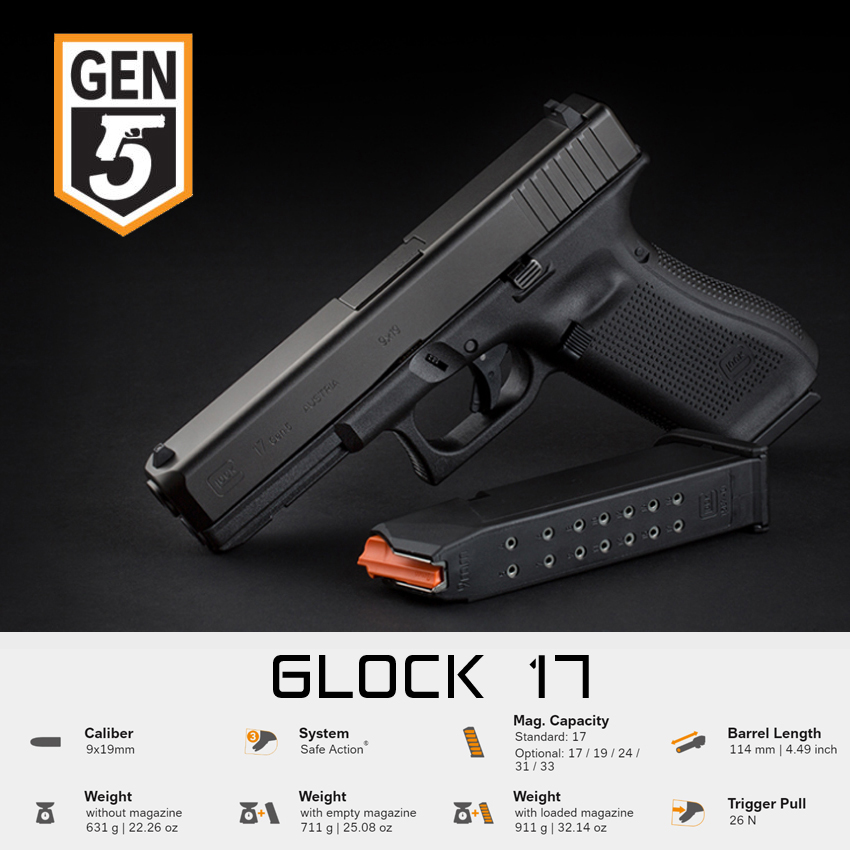


The Glock pistols have evolved across generations, with notable changes and improvements introduced in each iteration. Below are the key differences between Glock Generation 3, 4, and 5:
Glock Generation 3
Introduced: Early 2000s.
Grip Texture: Standard grip with less aggressive checkering compared to later generations.
Recoil Spring Assembly: Single recoil spring.
Backstraps: No modular backstraps (one-size grip).
Magazine Release: Standard, smaller magazine release button.
Slide Finish: Tenifer coating.
Finger Grooves: Introduced finger grooves on the front of the grip.
Trigger Mechanism: Classic Glock "Safe Action" trigger system.
Compatibility: Interchangeable parts with many other Glock models.
Glock Generation 4
Introduced: 2010.
Grip Texture: More aggressive texturing on the grip for better control.
Modular Backstraps: Interchangeable backstraps allowing customization of grip size for different hand sizes.
Recoil Spring Assembly: Dual recoil spring system for reduced recoil and improved durability.
Magazine Release: Enlarged and reversible magazine release for easier use by both left- and right-handed shooters.
Finger Grooves: Maintained the finger grooves on the grip.
Slide Finish: Improved finish over Generation 3, but still uses similar Tenifer coating.
Trigger Mechanism: Slightly modified trigger with a more consistent pull.
Magazines: Backward compatible with Generation 3, but Generation 4 magazines feature an extra notch for the reversible magazine release.
Glock Generation 5
Introduced: 2017.
Grip Texture: Retained aggressive texturing like Gen 4, but removed finger grooves, allowing more flexibility for various hand sizes.
Recoil Spring Assembly: Same dual recoil spring system as Gen 4.
Backstraps: Modular backstraps similar to Gen 4 for grip customization.
Magazine Release: Ambidextrous slide stop lever and reversible magazine release, improving left-hand ergonomics.
Slide Finish: nDLC (Diamond-Like Carbon) coating, offering better corrosion resistance and improved durability.
Barrel: Marksman barrel introduced, with enhanced rifling for improved accuracy.
Trigger Mechanism: Enhanced trigger design, providing a smoother pull and crisper break compared to previous generations.
Magazine Well: Flared magazine well for quicker reloads.
Magazine: Slightly modified design with orange followers for easier identification.
Parts Compatibility: Some internal components are not compatible with earlier generations.
Key Differences:
Finger Grooves: Present in Gen 3 and 4, removed in Gen 5.
Recoil Spring: Single in Gen 3, dual in Gen 4 and 5.
Grip Customization: Gen 4 and 5 offer interchangeable backstraps, while Gen 3 does not.
Magazine Release: Gen 4 and 5 have enlarged and reversible releases; Gen 5 adds an ambidextrous slide stop lever.
Barrel: Gen 5 introduces the Glock Marksman barrel for improved accuracy.
Slide Finish: Gen 5 introduces nDLC coating for better durability compared to earlier generations.
Each generation introduces incremental improvements in ergonomics, durability, and accuracy, catering to both casual users and professional operators.
DIFFERENCES IN GLOCK GENERATIONS



- Glock Pistols are shipped in cardboard boxes (55X32X26cm each box) on EUR-pallets (1200x800 mm).
- Each cardboard box contains 10 pistols each in a separate polymer case.
- A maximum of 20 cardboard boxes, each filled with 10 pistol cases, can be placed onto one EUR pallet.
- The net weight of each pistol: 1.48kg
- The gross weight of each pistol: 1.55kg
- The weight of a fully loaded palette is about 315-320kg


